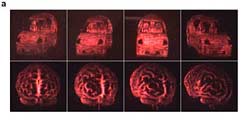Scientists in the United States on Wednesday unveiled next-generation 3-D technology that they said provided realistic, updatable holograms in nearly real time.
The innovation could one day lead to 3-D holographic movies, enabling cinema-goers to feel they are "inside" a movie yet not have to wear cumbersome, headache-inducing spectacles with polarising or coloured lenses, the inventors hope.
Other beneficiaries include military commanders, who could gain a three-dimensional picture of a battlefield, and surgeons performing complex micro-surgery inside a patient.
In a paper released by the British journal Nature, Nasser Peyghambarian of the University of Arizona and colleagues reported how they recorded, displayed and updated images on a palm-sized screen measuring just 10 centimetres by 10 centimetres (four inches by four inches).
Holograms are created by shining a laser on an object, whose image falls onto a photosensitive screen. At the same time, a second laser beam falls on the screen, creating an "interference pattern" -- in essence, the condensed contours of the object, which are imbedded in the film.
It takes a third laser, called the reading beam, to be directed onto the screen for the interference pattern to be resurrected. To a person in front of the screen, this creates an image in three dimensions that appears in mid-air behind the screen.
These holograms are widely used in advertising, art and entertainment but the drawback is that their displays are static.
The new technology, though, can store the image, erase it and update it, say the inventors.
Although still at a prototype stage, it means that one day a 3-D motion picture is a clear possibility, they believe.
The secret lies in films called photorefractive polymers which contain molecules of dye that respond to light and rotate and line up in response to an applied electrical field.

